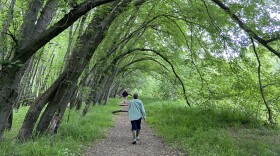This week, we're revisiting two essays originally produced in 2014 and 2015. The Robert Frost poem, Unharvested, is read by Sean Hurley.
Wild apples
This essay was written by Chris Martin.
October brings crisp air and crisp apples. An October tradition I recommend is searching for the perfect wild apple.
Admittedly, most wild apples are what's known as "spitters." Take a bite, and you spit it out. That makes it all the more rewarding when you do find a pleasing one.
A perfect wild apple is, in fact, where some great apple varieties began. The very first McIntosh came from a wild tree that John McIntosh of Ontario happened upon 200 years ago. An apple seedling doesn't grow true to its parent, however. Plant 50 seeds from one tree and you'll get 50 different apples, each manifesting different qualities. So John McIntosh and his son Allan cut twigs from that first wild tree and grafted them to growing rootstock. Every McIntosh tree today is grafted, a clone of that original wild tree that was first encountered quite by chance.
In more recent times, apple varieties come from the plant nursery, not the wild. The increasingly popular Honeycrisp was developed and trade-marked by the University of Minnesota by crossing Macoun and Honeygold. All Honeycrisps grown since are clones of that original hybrid.
There's a world of character apples beyond the familiar McIntosh, Granny Smith and Red Delicious varieties that usually travel long distances to reach store shelves. Search out the small orchards that offer heirloom apples like Stayman Winesap, Duchess of Oldenberg, or Thomas Jefferson's favorite, Esopus Spitzenberg. And if you do find a wild apple that pleases you: Next spring, graft a twig or two and start your own named variety.

Fallen apples
This essay was written by Dave Anderson.
Robert Frost's apple poem, "Unharvested," begins:
A scent of ripeness from over a wall.
And come to leave the routine road
And look for what had made me stall,
There sure enough was an apple tree
That had eased itself of its summer load,
And of all but its trivial foliage free…
Birds rustle amid leaves in the layered canopy of apple boughs overhead. The upper boughs of these — my favorite trees — are heavy with apples ripening in the September sun.
Soon, apples will begin to fall, hitting the ground with a hollow thud. Everywhere, sweet, windfalls litter the orchard floor. They lie broken and bruised; their soft brown flesh gone mealy.
I pick through firmest fruit to find most are flecked with brown scabs of apple rust or black, powdery mildew. Only a rare few had ripened to perfection, fallen, bounced and rolled to rest resplendent in the green grass. But be careful before you bite one! Hidden hornet and ant tunnels riddle the fallen fruits. By night, the deer, coyotes and a bear visit to crunch and slurp sweet apple slurry.
The season of falling apples and longer nights has arrived. Soon, the last early Macs will rot and dissolve in the frosty grass.
Speaking of "Frost," he ends his poem:
… The ground was one circle of solid red.
May something go always unharvested!
May much stay out of our stated plan,
Apples or something forgotten and left,
So smelling their sweetness would be no theft.
Something Wild is a partnership of New Hampshire Audubon, the Forest Society and NHPR, and is produced by the team at Outside/In.











